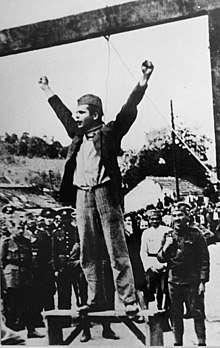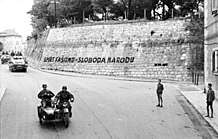Death to fascism, freedom to the people
"Death to fascism, freedom to the people!" (Serbo-Croatian: Smrt fašizmu, sloboda narodu! / Смрт фашизму, слобода народу!, Slovene: Smrt fašizmu, svoboda narodu!, Macedonian: Смрт на фашизмот, слобода на народот!, Albanian: Vdekje fashizmit, liri popullit!) was a Yugoslav Partisan motto, afterward accepted as the official slogan of the entire resistance movement, that was often quoted in post-war Yugoslavia. It was also used as a greeting formulation among the movement members both in official and unofficial correspondence during the war and for a few subsequent years, often abbreviated as "SFSN!" when written and accompanied by the clenched fist salute when spoken (one person usually saying "Smrt fašizmu!", the other responding with "Sloboda narodu!").


History
The slogan became popular after the execution of Stjepan Filipović, a Yugoslav Partisan. As the rope was put around his neck on 22 May 1942, Filipović defiantly thrust his hands out and denounced the Germans and their Axis allies as murderers, shouting "Death to fascism, freedom to the people!". At this moment, a subsequently-famous photograph was taken from which a statue was cast.[2]
The August 1941 edition of the Croatian daily newspaper Vjesnik, then the primary media publication of the Partisan resistance movement, featured the statement "Smrt fašizmu, sloboda narodu".
The slogan was part of the Communist Party of Yugoslavia's 1941 call to arms for the people of Yugoslavia.[3] The Bulletin of the Partisan Supreme Headquarters uses the slogan in its first issue dated 16 August 1941.[4]
References
- Istvan Deak; Europe on Trial: The Story of Collaboration, Resistance, and Retribution during World War II p. 159; Routledge, 2013, ISBN 0813347890.
- Sinclair, Upton; Sagarin, Edward; Teichnerhe, Albert; Cry for Justice: An Anthology of the Literature of Social Protest p. 438; L. Stuart, 1963.
- Jon C. Hopwood. "IMDB Mini Biography for Josip Broz Tito". IMDb. Retrieved 2012-04-14.
- Zbornik dokumenata i podataka o narodno-oslobodilačkom ratu jugoslovenskih naroda. T. 2, kn. 1, Vojnoistoriski Institut, Beograd 1949, OCLC Number: 837183093, pages 17-18